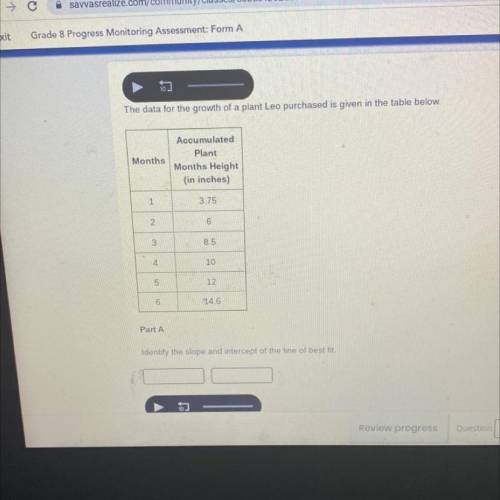
Mathematics, 03.06.2021 07:20 damyonfenton13
25 POINTS !Pls answer it correctly!! I will report you if you answer the question with no answer ...
The data for the growth of a plant Leo purchased is given in the table below.
Months
Accumulated
Plant
Months Height
(in inches)
Part b
A . When Leo bought the plant it was about 4 inches in height and it continue to grow approximately the same amount for the next six months
B . Leo brought the plant it was 4 inches in height and continue to grow approximately 1 inch each month
C . Leo bought the plant it was about 2 inches in height and continue to grow approximately 1 inch each month
D . Will you want to plan it was 2 inches in height and you continue to go possibly 2 inches each month


Answers: 2
Another question on Mathematics

Mathematics, 21.06.2019 17:10
How many lines can be drawn through points j and k? 0 1 2 3
Answers: 2

Mathematics, 21.06.2019 19:00
In the figure below, ∠dec ≅ ∠dce, ∠b ≅ ∠f, and segment df is congruent to segment bd. point c is the point of intersection between segment ag and segment bd, while point e is the point of intersection between segment ag and segment df. the figure shows a polygon comprised of three triangles, abc, dec, and gfe. prove δabc ≅ δgfe.
Answers: 1

Mathematics, 21.06.2019 21:30
In a test for esp (extrasensory perception), the experimenter looks at cards that are hidden from the subject. each card contains either a star, a circle, a wave, a cross or a square.(five shapes) as the experimenter looks at each of 20 cards in turn, the subject names the shape on the card. when the esp study described above discovers a subject whose performance appears to be better than guessing, the study continues at greater length. the experimenter looks at many cards bearing one of five shapes (star, square, circle, wave, and cross) in an order determined by random numbers. the subject cannot see the experimenter as he looks at each card in turn, in order to avoid any possible nonverbal clues. the answers of a subject who does not have esp should be independent observations, each with probability 1/5 of success. we record 1000 attempts. which of the following assumptions must be met in order to solve this problem? it's reasonable to assume normality 0.8(1000), 0.2(1000)%30 approximately normal 0.8(1000), 0.2(1000)% 10 approximately normal srs it is reasonable to assume the total number of cards is over 10,000 it is reasonable to assume the total number of cards is over 1000
Answers: 1

You know the right answer?
25 POINTS !Pls answer it correctly!! I will report you if you answer the question with no answer ......
Questions



History, 05.02.2020 13:03

History, 05.02.2020 13:03




Physics, 05.02.2020 13:03

Arts, 05.02.2020 13:03


Computers and Technology, 05.02.2020 13:03


History, 05.02.2020 13:03

Chemistry, 05.02.2020 13:03



Mathematics, 05.02.2020 13:03

Chemistry, 05.02.2020 13:03


English, 05.02.2020 13:03



